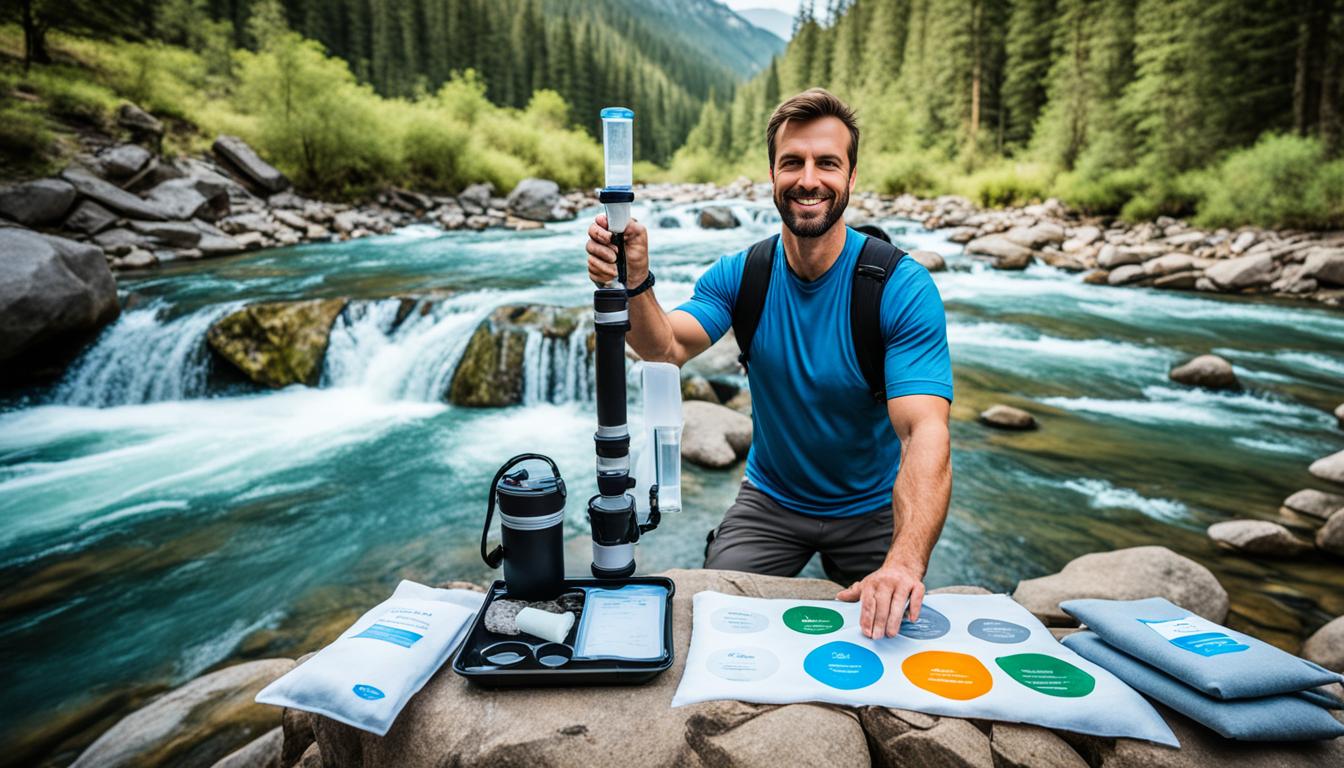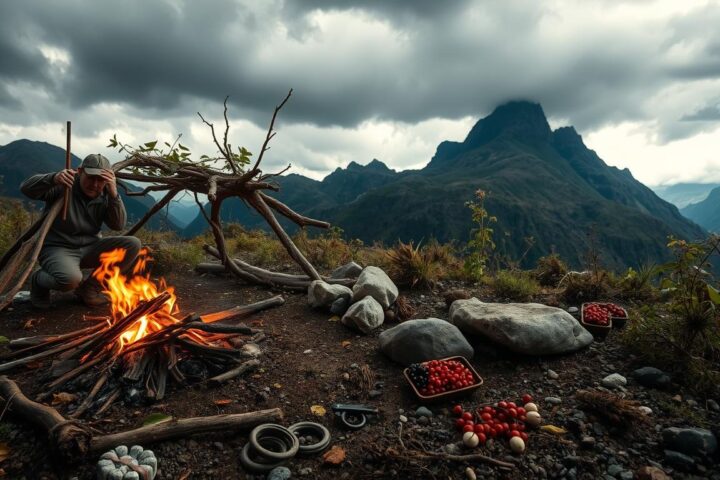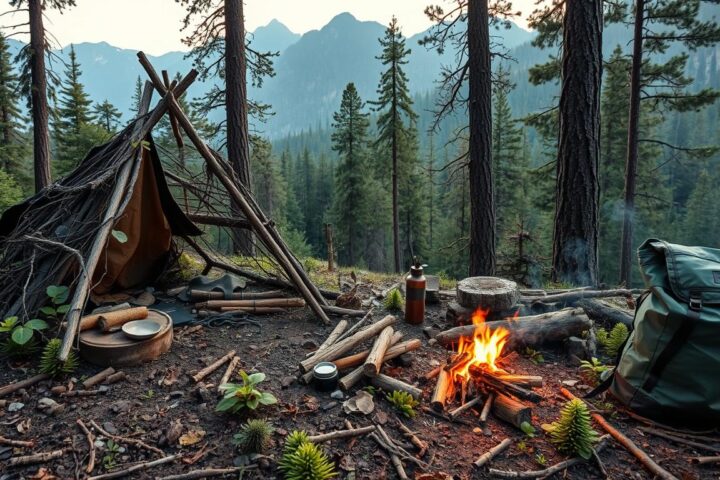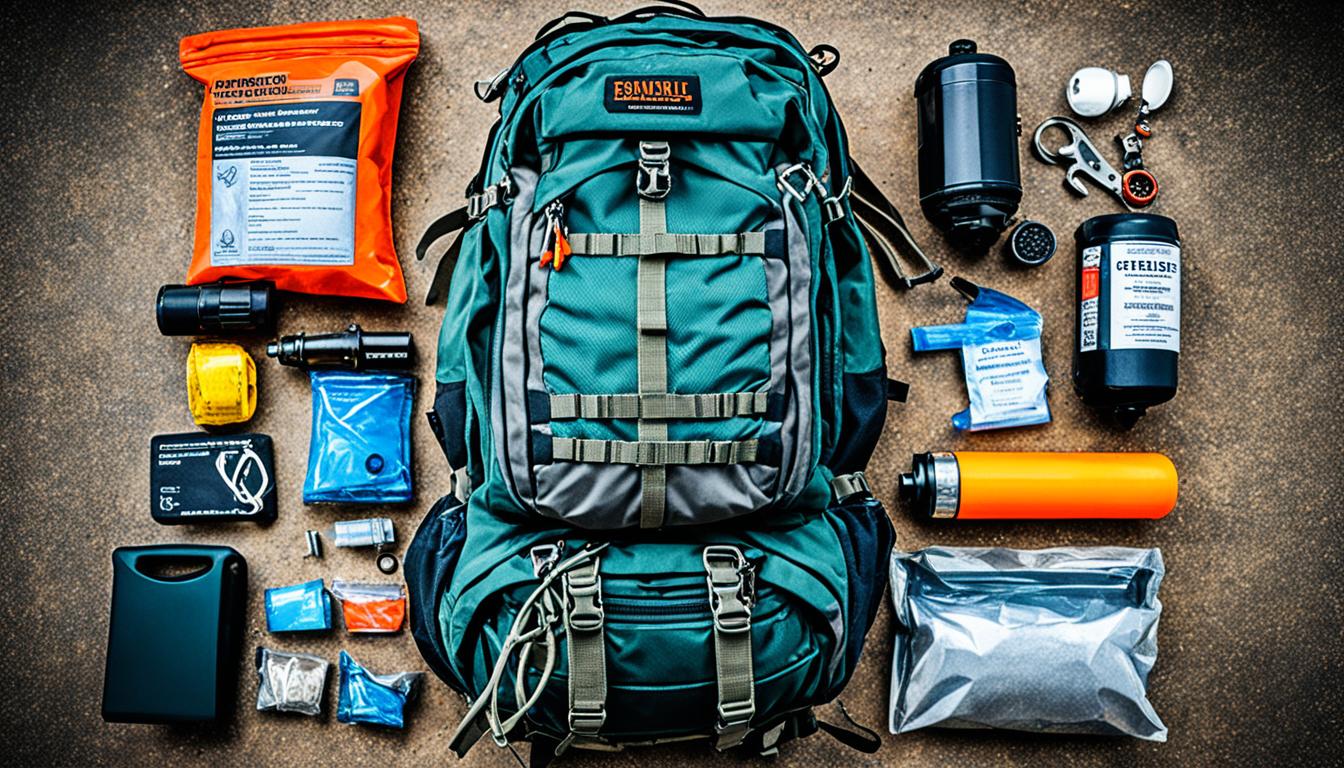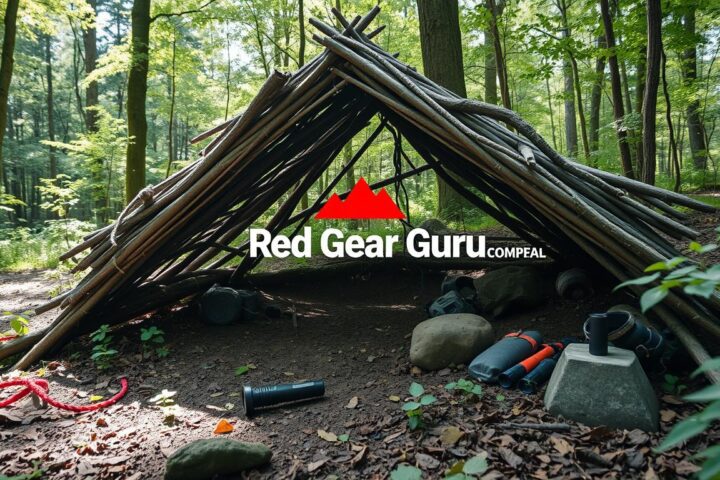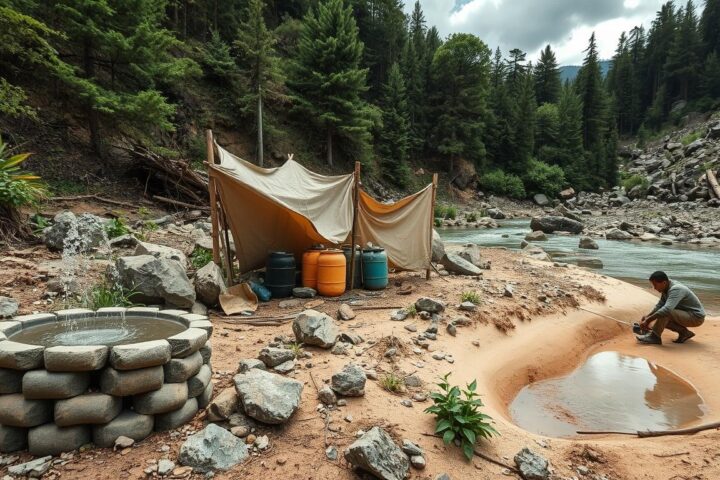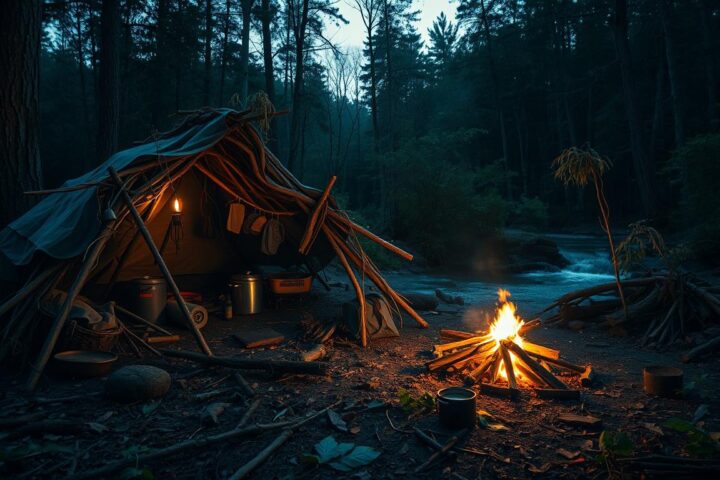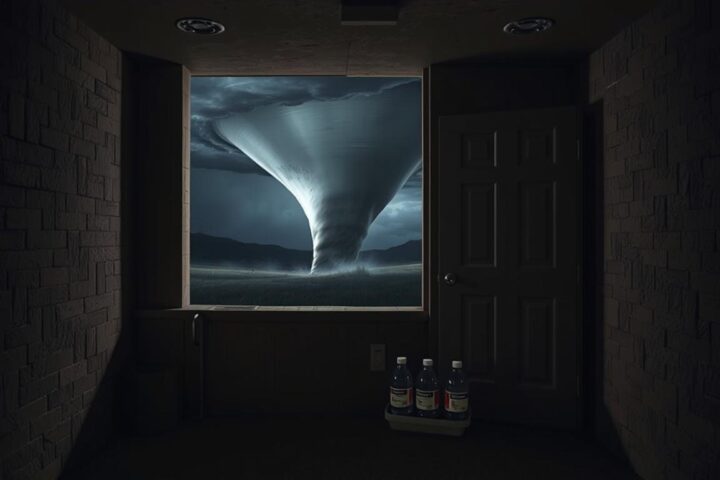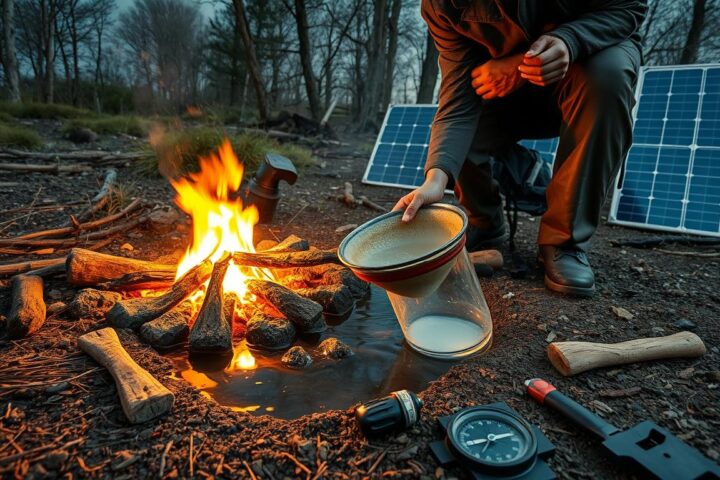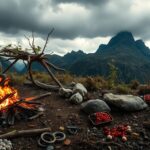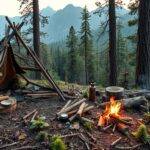The human body can only last three days without drinking water. This makes having clean water vital for survival. Water is more than two-thirds of our body weight, showing its key role in keeping us alive.
Lakes, rivers, and streams can have harmful parasites and pathogens. These can make us sick if we drink them. That’s why learning how to purify water is crucial for outdoor adventures.
This guide will cover various survival water purification methods and water filtration techniques. You’ll learn how to make any water safe to drink. This includes using commercial filters, UV treatments, boiling, and even plants to purify water.
Key Takeaways
- Water is essential for human survival, making up over two-thirds of our body weight.
- Surface water sources like lakes and streams are prone to contamination and require purification before drinking.
- Purification methods range from commercial filters and UV light to boiling, chemical treatments, and plant-based solutions.
- Mastering survival water purification techniques is crucial for outdoor enthusiasts and disaster preparedness.
Introduction
When you’re in a survival situation, having clean drinking water is key to staying healthy and alive. Without it, you won’t last more than a few days. Wild water often has thousands of harmful microorganisms and bacteria. These can make you very sick or even kill you if you drink it without cleaning it first.
Sources of Water Contamination
Wild water comes from three main sources: surface water, groundwater, and atmospheric water. Each can have pollutants like fecal matter, protozoan parasites, E. coli, agricultural runoff, heavy metals, and radiation. It’s important to know what might be in your water to choose the right way to clean it.
- Surface water, like streams, ponds, and lakes, can be dirty from animal waste, industrial waste, and farm runoff.
- Groundwater, found in wells or springs, might have minerals, heavy metals, or radioactive stuff.
- Atmospheric water, like rain or dew, can be dirty from air pollution and germs in the air.
Understanding the importance of clean water and the sources of water contamination in survival situations helps keep you safe in the wild.
Water Filtration Systems
Understanding water filtration systems is key for survival. You can make your own filters or use activated charcoal to clean water. This helps remove physical contaminants and makes the water safer in emergencies.
Home-Made Filters
Making your own water filter is a handy skill for the wild. You just need simple things like sand, rocks, and a container. By layering these, you can make a filter that takes out big particles and debris. It’s not perfect, but it’s a good first step in cleaning the water.
Activated Charcoal Filters
Activated charcoal is great for cleaning water. It can catch many contaminants like chemicals, smells, and color changes. Using an activated charcoal filter can make the water taste better and safer to drink in survival situations.
Even with homemade water filters or activated charcoal water filters, you’ll need more steps to make the water safe. Boiling or chemical treatment is usually needed to kill all harmful germs.
Boiling Water
Boiling water is a top choice for making it safe to drink in survival situations. It kills most bacteria and microorganisms with its high heat. This method is key for those heading into the wilderness where clean water might be scarce.
Even murky water from lakes or ponds can be made safe by boiling. With a strong container and a good fire, you can have clean water in about 10 minutes. Make sure the water boils for at least five minutes to kill harmful germs.
But, boiling dirty water might not get rid of all risks. Dirt or leaves can still make the water unsafe. Always use the cleanest water you can find before boiling it.
Learning how to boil water for survival is crucial. It ensures you have safe drinking water in tough outdoor situations. This skill can be a lifesaver.
Chemical Treatments
When you’re in the wild, you might not have fancy water filters. Chemical treatments can save your life. Purification tablets or drops with iodine, chlorine, and potassium can kill harmful germs in your water. But, they might make your water taste bad.
Iodine and Chlorine Tablets
It’s important to know how much water to treat with chemical water purification treatments. Most iodine and chlorine water purification tablets work for about 20 liters. Make sure you measure right.
Before adding the treatment, filter the water until it’s clear. This makes the treatment work better.
Chemical water purification treatments aren’t the tastiest option. But, they’re a good backup when you can’t use other methods. Just follow the instructions and wait for the chemicals to do their job.
Distillation
Distillation is a great way to clean water, especially in places with lots of sodium and minerals. You can use a smaller container inside a bigger one with salt water and cover it. This lets condensation separate the water from salts and minerals. It doesn’t make the water completely clean, but it does purify it. Then, you can filter it with an emergency water filter.
Solar Stills for Water Purification
Solar stills use the sun’s power to make clean water. They work well in dry and tropical areas where the sun’s heat can be used. By making a simple solar still, you can have a steady supply of clean water when you need it.
To make a solar still, dig a hole and put a container in the middle. Cover the hole with a clear plastic sheet, holding it down with rocks or soil. Put a small rock or weight in the center to make a slight dip.
As the sun heats the soil and water, the water will evaporate. It will then condense on the plastic and drip into the container below. This gives you purified water.
Solar stills are a simple and effective way to distill water for purification in survival situations. They don’t need complex gear or fuel. This method is very useful in places where water distillation for purification is key for staying hydrated and healthy.
survival water purification methods, water filtration techniques
Having clean, safe drinking water is key in survival situations. Luckily, there are many water purification methods and filtration techniques to keep you hydrated. Whether you’re lost in the woods or facing a disaster, these options can help. From portable water filters to using plants, you have many ways to purify water.
Activated charcoal filters are a top choice for cleaning water. They remove many contaminants, like chemicals and heavy metals. Making your own charcoal filter can save money, but it doesn’t last as long as store-bought ones. To kill all germs, you might need to boil the water or use chemicals.
Here are more ways to purify water for survival:
- Boiling water to kill germs
- Using chemical treatments like iodine or chlorine tablets
- Distillation, which cleans water by heating and cooling it
- Plant-based purification, using plants that kill germs
- Stone boiling, a way to heat water in the wild
With these outdoor hydration solutions and remote water sterilization methods, you’re ready for any situation. You’ll always have clean water for drinking, keeping you safe during disasters.
Plant-Based Purification
Modern ways to clean water include boiling, filtering, and using chemicals. But nature also has tools for making water safe. Some wild plants have properties that kill germs in water.
Antimicrobial Plants
The Oregon Grape is one such plant. It has a substance called berberine that fights germs. By using Oregon Grape leaves or roots to filter water, you can make it safer to drink.
Citrus fruits and their seeds also work well for cleaning water. They have natural germ-fighting properties.
But, you must know these plants well before using them for cleaning water. If you get it wrong, it could be dangerous. Use them only when you have no other choice.
Plant-based methods can be useful for survival. But they might not always work as well as other ways. Always test and learn about these natural methods before counting on them in an emergency.
Stone Boiling
When you’re without the right gear to boil water, stone boiling is a great option. This method heats rocks in a fire until they’re super hot. Then, you carefully put them into water using wooden tongs. The hot rocks make the water boil, killing harmful germs and making the water safe to drink.
The best vessels for stone boiling are big, hollowed-out rocks. If the water doesn’t boil right away, keep adding hot rocks until it does. Or start over if needed.
This improvised water boiling technique goes way back, about 5,000 years. It started in Northern America as a way to purify water with natural materials. It’s still important for bushcraft and survival today.
- It usually takes 30 to 45 minutes to heat the rocks enough for stone boiling. This depends on the rock type and the fire’s strength.
- Think about the rock’s porosity and permeability to avoid them exploding when heated.
- Drop hot rocks one by one into the water until it starts boiling.
- You’ll need about 2 dozen egg-sized or smaller stones to boil 2 to 4 quarts of water.
After using the rocks for boiling, check if they’re still good for reuse. Some rocks like slate, shale, quartz, or obsidian might explode in the fire within the first 15 minutes.
Learning how to use stone boiling for water purification means you can always have safe drinking water, even in tough situations.
Sedimentation
In survival situations, clean water might be hard to find. Sedimentation is a simple way to purify water. It works by letting water sit still for a while. This lets dirt and other stuff settle at the bottom.
Then, you can take the clean water from the top. This method is great for murky water. It removes dirt, sand, and other stuff before you clean it more.
By letting dirt settle, your water gets cleaner and safer. This makes your water purification better.
Sedimentation is easy and doesn’t need much gear. You just need a container to hold the water. Let it sit still for a few hours or overnight.
As the dirt settles, the water above gets clearer. You can then take out the clean water for more cleaning.
Maximizing the Benefits of Sedimentation
Here are some tips to make sedimentation work better:
- Allow for Sufficient Time: The longer the water sits, the better it cleans. Try to wait 4-6 hours or even longer if you can.
- Use Multiple Containers: Using more containers helps get rid of more dirt. This makes the water cleaner.
- Carefully Decant the Water: When taking out the clean water, do it slowly and carefully. Don’t stir up the dirt at the bottom.
Adding sedimentation to your water cleaning routine helps remove a lot of dirt. This makes it ready for more cleaning steps. It’s a key method in survival when clean water is hard to find.
Conclusion
Learning how to purify water is key in survival situations. We’ve looked at different water sources, contaminants, and ways to make water safe. From using commercial filters to making your own, knowing these methods is vital.
Having safe drinking water is crucial, especially when you’re lost or in a disaster. The right water filtration techniques can help you survive. So, being ready with these skills is important.
Did you know 1 in 3 people worldwide don’t have access to clean water? This leads to 485,000 deaths each year from contaminated water. Clean water is essential for good health, preventing serious illnesses.
By learning how to purify water, you can protect yourself and your loved ones. This knowledge is crucial for survival. It can save lives.
Access to clean water can mean the difference between life and death. So, learn about different ways to purify water. Being prepared could save your life one day.
